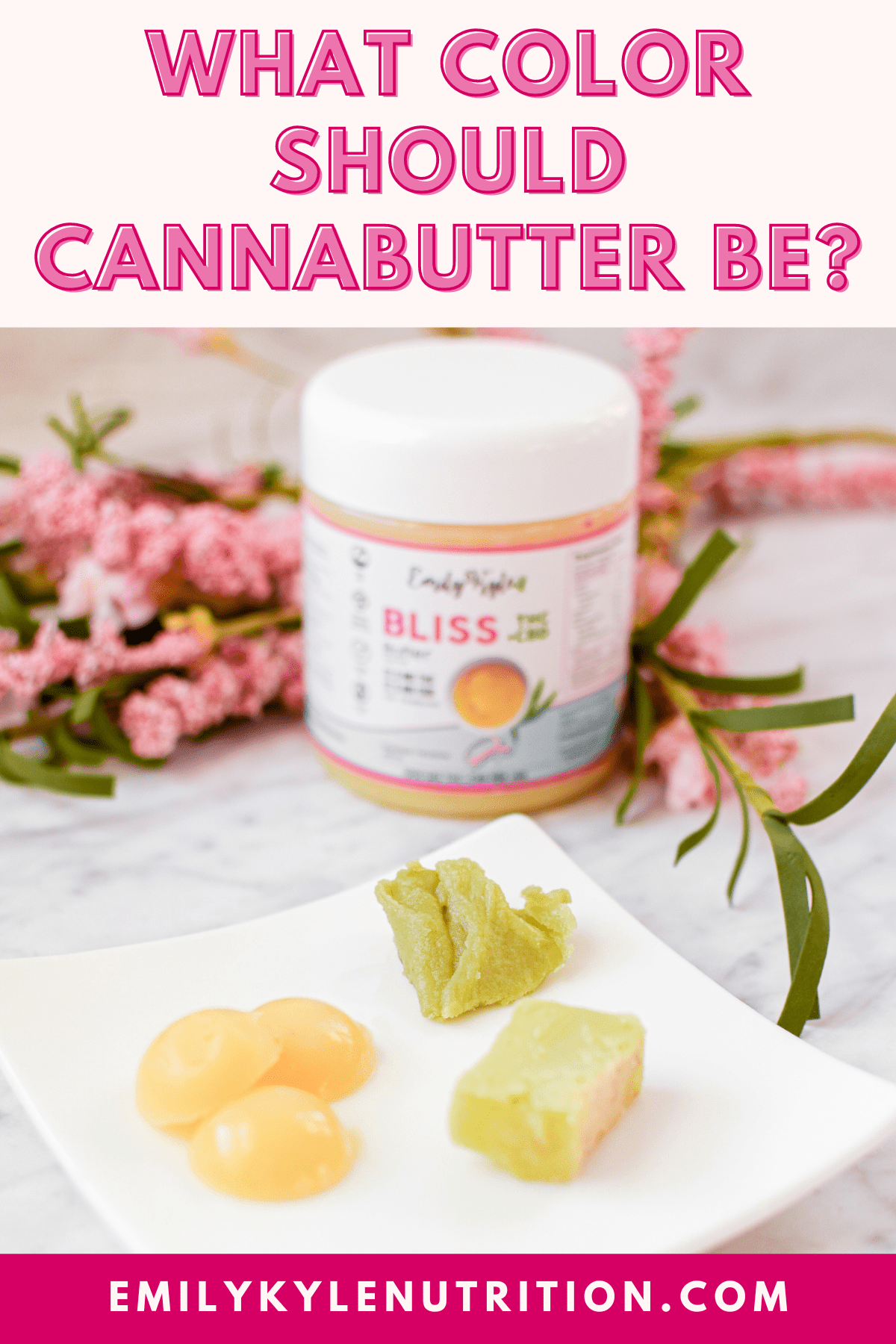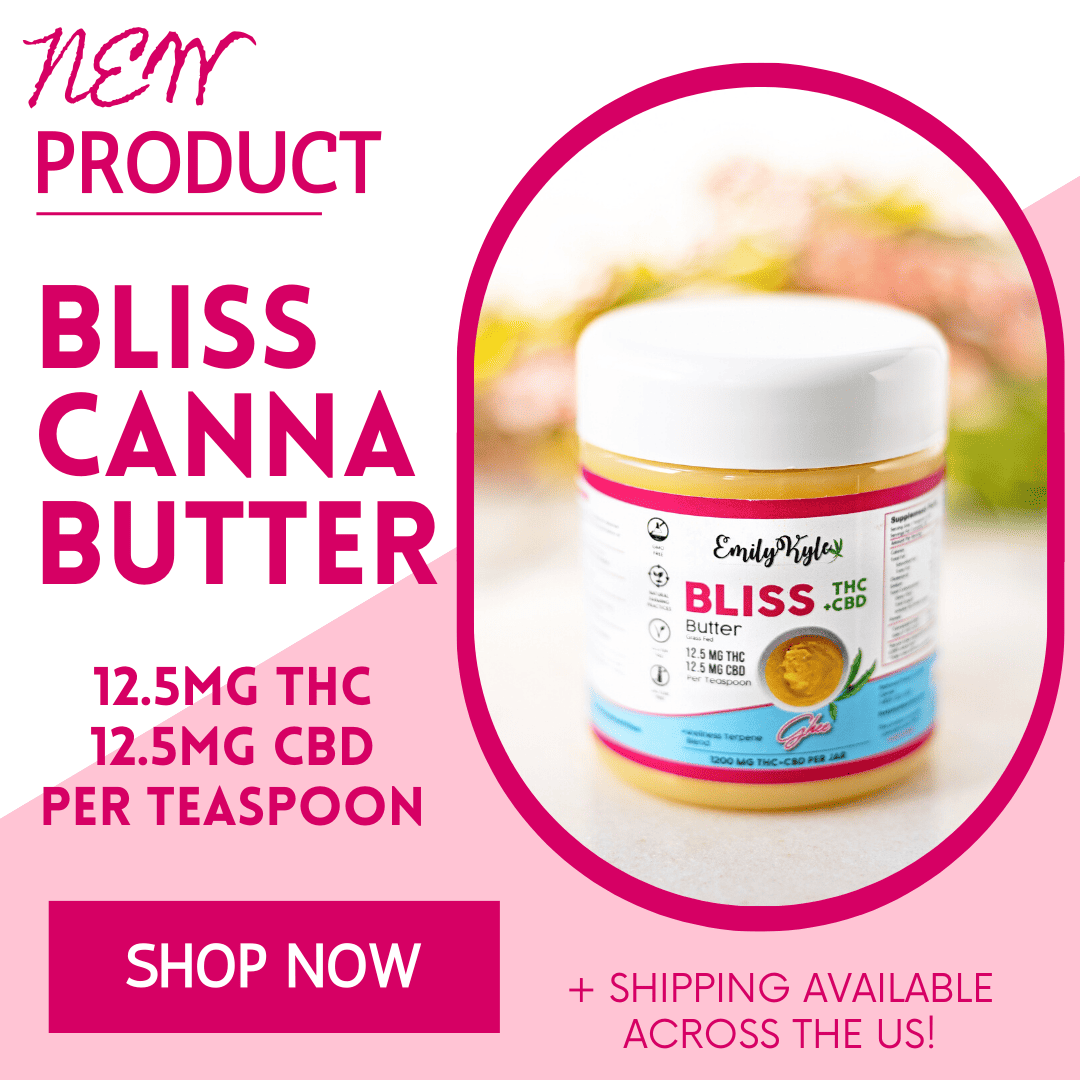Did you make a super green or pale yellow cannabutter and wonder, “what color should cannabutter be?” Did you know that the color of the cannabutter does not indicate the potency at all? Find out what it means instead, and how to make better tasting butter in the end.

Table of Contents
Article Features
- Why it doesn’t matter what color your cannabutter is
- How to make cannabutter that looks and tastes better
- Want to skip the work? Enjoy the convenience and exceptional flavor of my Bliss Cannabutter – no fuss, no mess, just top-quality cannabutter delivered straight to your door. Now shipping across the United States!

Why You Will Love This Guide
Have you gone through all the steps to make cannabutter at home, only to feel some way when you look at the color of the container the next day?
Recently a member of my Well With Cannabis Community reached out and said: “I made cannabutter last night, but it’s not green. Is it supposed to be this color? Did I do this right?”
Have no fear! Here I will talk about why the color of your cannabutter has NO reflection on the potency and what the color really tells us instead.
This guide will give you the full breakdown of why it doesn’t matter what color your cannabutter is, my tips and tricks for making better cannabutter, and lots of favorite recipes to try.
Color Doesn’t Matter
The short answer? The first thing you need to know is that the color of your cannabutter has no meaning.
A green cannabutter is not “better” than a pale yellow cannabutter or vice versa.
The final product’s color does not indicate the potency or effectiveness of the final product.
As cannabis users, it’s essential to know this so we can stop focusing on what doesn’t matter, the color, and focus on what does matter, the potency, and how we can take our edibles to the next level.
Let’s explore what color means and how it can affect your edible’s taste.

The Color of Chlorophyll
The beautiful cannabis plant in the vegetative stage is typically a vibrant green color, mainly due to a pigment called chlorophyll.
Chlorophyll helps the plant to make food and produce oxygen through a fantastic process called photosynthesis.
There are many proven health benefits to consuming chlorophyll, but most cannabis consumers do not love this pigment due to its bitter taste.
Chlorophyll pigments are most abundant when cannabis is in its raw form; however, it can also be found in dried and processed plant material.
When making edibles, these chlorophyll pigments can be transferred from the plant material into the final infusion, making it appear green.
Along with color, chlorophyll adds an unwanted taste that can be very “grassy” and unpleasant.
That is why you may find that very green marijuana butter has a much more prominent “green” taste, flavor, and smell.

Ways to Reduce Chlorophyll in Infusions
Now it all comes down to personal preference; at the end of the day, it’s up to you.
Many people love the taste of cannabis and simply add it directly to their foods.
Others can’t stand the taste and gag at the thought of swallowing a teaspoon of butter.
If you like the taste and enjoy it with your homemade edibles, more power to you.
But if you want to reduce the taste by reducing the amount of chlorophyll in the end product, try these tips:
- Opt for dried cannabis when possible. Fresh or raw cannabis contains much more chlorophyll than dried.
- Select cannabis buds or cannabis flowers over other parts of the plant. Fan leaves, trim leaves, sugar leaves, or shake will all contain more chlorophyll.
- Do not grind the cannabis before adding it to a recipe.
- Decide how much weed you really need to add. More product = more taste.
- Try a different extraction process. The QWET method is excellent when making tinctures.
- Opt for other cannabis products like concentrates which have little to no taste
- Be careful when straining, as crushing the plant matter may release more chlorophyll into the finished product. If you’re using a fine mesh strainer or cheesecloth, be sure not to squeeze or crush the plant material during the process
- Watch your infusion times. Super-long infusions, over 8-24 hours long, will result in more green infusions. 4 hours is enough time for infusion.

Color Does Not Indicate Potency
Remember the old saying: “don’t judge a book by its cover?”
One common misconception I often see is that many people think that the color of the butter is an indicator of potency.
I have heard people say: “look how green it is; this is some potent cannabutter.”
And on the opposite side, I’ve heard people say: “it never turned green; did I mess something up?”
But unfortunately, that is just not true. The color is only a reflection of the amount of chlorophyll present and not an indicator of potency.
The Same is True for Oil
If you decide to venture into the world of infused cannabis oil, know that the same theory is applied.
Whether you’re making infused coconut oil, MCT oil, or olive oil, the final product’s color will still reflect how much chlorophyll has been infused.
If you want to reduce your cannabis-infused oil’s green color and taste, follow the suggestions above.
Notes & Expert Tips
- Tired of all the steps it takes to make cannabutter? Try my Bliss cannabutter instead and have it delivered directly to your doorstep, perfectly portioned with 12.5 mg of CBD and 12.5 mg of THC per teaspoon
- When possible, don’t use regular butter. Options like unsalted butter or salted butter will reduce separation and loss of volume. To save time and product, opt for ghee or clarified butter instead. This makes the process much easier!
- Don’t forget that you can save the leftover plant matter from your cannabis infusion to use in other recipes.
- Do not grind the cannabis before making cannabis butter. Break the buds into smaller pieces before the infusion process.
- If this is your first time making cannabis edibles, check out my beginner’s guide before getting started!
- Worried you’ve made a weak cannabutter? Don’t worry; we can fix that!
Frequently Asked Questions
Yes, when making cannabutter, you want to undergo the decarboxylation process before the cooking process to activate the THC or CBD in the product. Raw cannabis contains CBDA or THCA (tetrahydrocannabinolic acid), which is non-intoxicating, meaning you may not experience the effects you are looking for. Decarboxylated cannabis will contain active forms of THC. The process is simple: place the cannabis on a baking sheet or in a mason jar and bake in the oven or Instant pot for a set amount of time.
This can happen for various reasons, most if you used aged cannabis. Old cannabis will lose its green color over time and turn to a more brown or yellow color, affecting your final product.
If you want to calculate the amount of THC in your favorite edible recipe, you need to start with the infusion. You will need to know two things, the % THC of the flower you’re working with and how much of that flower you used in grams. From there, you can input this information into the edible dosage calculator to get a guestimate of how much THC is in your final weed butter recipe. Remember, the potency of your cannabutter is just a guestimate unless you go through lab tests.
The good news is that it is perfectly safe to bake your edibles at high temperatures. While the high heat may seem nerve-wracking, remember, the temperature of the food never gets that high.
If you are going to store it at room temperature, leave it out for 3-5 days. Store in the refrigerator in an airtight container for 2-3 weeks. Freezing the cannabutter is a good choice for long-term storage and the best results. Learn more about storing edible best practices here.
Yes, you can definitely use cannabis to fuel a healthy lifestyle and make healthy recipes. From sugar-free recipes to low-carb recipes like cannabutter steak, there are so many options to choose from.
Cannabutter Recipes to Try
Ready to make cannabutter at home? I have a step-by-step guide for just about every cooking method.
They all follow the same process. The first step is to select how much cannabis and how many sticks of butter you want to use. Be sure to record the amount of cannabis you used if you want to calculate the final dose.
Then it’s time for the decarbing process, which you can do in an oven or Instant pot. Once the chemical compounds are turned into the active ingredients you want, you can start the water bath process.
You can use a crock pot, sous vide, double boiler, or any other option listed below. Remember, there is no one best way, just a way that works for you!
- Crockpot or slow cooker cannabutter
- Instant Pot cannabutter
- Stovetop cannabutter
- Kief cannabutter
- CBD cannabutter

More Cannabutter Guides
All Things Cannabutter
A Guide to Cannabutter Separation » What is Normal?
Articles & How-To Guides
How to Store Cannabutter for Maximum Freshness
Articles & How-To Guides
How to Fix Weak Cannabutter – Tips & Tricks
Articles & How-To Guides














